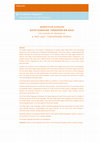Papers by Elisabetta Ragagnin

Proceedings of the 4th Mikola Conference - 14-15, November 2014
Sayan Turkic is the technical term used in Turcology to refer to the South-Siberian branch of the... more Sayan Turkic is the technical term used in Turcology to refer to the South-Siberian branch of the Turkic language family, which includes standard Tuvan, Tofan and various related languages spoken by small communities in neighbouring Mongolia, China and Buryatia Sayan Turkic can be further divided into two groups: Steppe Sayan Turkic and Taiga Sayan Turkic. To the former belong Standard Tuvan and its dialects together with Altay-Sayan varieties spoken in China and western Mongolia, and Uyghur-Uriankhay (Tuhan) of East Khövsgöl. The traditional lifestyle of Taiga Sayan Turkic peoples used to be based on low-land i.e. steppe pastoralism, characterized by herding of sheep, goats, cattle (cows and yaks), horses and camels. The Taiga Sayan Turkic branch includes Tofan, the Toju variety of Tuvan and some varieties of the Tere-Khöl area as well as Soyot of Buryatia and Dukhan of Mongolia's northern Khövsgöl Aimag. Reindeer breeding and hunting has characterized the lifestyle of these groups until recently. 1 During the last decades reindeer herding has dramatically decreased in the Taiga-Sayan area-see, for instance, Donahoe and Plumley (2003). Presently, reindeer herding is best maintained among the Dukhan people.

Azerbaijan lies in an extremely propitious position between the Caucasus and the Caspian Sea, and... more Azerbaijan lies in an extremely propitious position between the Caucasus and the Caspian Sea, and has always been an important stop along the Silk Road, and a melting pot of languages and cultures. Many ethnic, religious and linguistic groups passing through or settling in the territories of present-day Azerbaijan historically came into contact with local communities, hence contributing to this linguistic mosaic. Investigating languages of Azerbaijan is interesting and important not only from the linguistic point of view. It also bears a sociocultural value in that it can offer a new perspective on studying these languages from the standpoint of their vitality and maintenance. This volume offers new data and highly valuable insights into various linguistic and sociolinguistic aspects of the East Caucasian, South Caucasian as well as the Iranian varieties spoken in Azerbaijan. With this publication, we hope to set in motion more linguistic activities and research initiatives on the different varieties forming Azerbaijan's languages treasure, including Azerbaijanian dialects-many of which display highly interesting features due to contact with the languages presented in this volume.

Tehlikedeki Diller Dergisi - ISSN: 2148-130X, Jun 1, 2012
The Dukhan people live in the county of Tsagaannuur (in Dukhan Akköl 'White Lake') and surroundin... more The Dukhan people live in the county of Tsagaannuur (in Dukhan Akköl 'White Lake') and surrounding taiga areas in the northern part of Mongolia's Khövsgöl region. Their total number is approximately 500 people. Dukhans are divided into three groups: 1) the Dukhans living in the high taigas, divided into West vs. East Taiga, 2) the Dukhans living in river areas, and 3) the Dukhans living in Tsagaannuur. The Dukhans living in the taiga lead a lifestyle based on reindeer herding, gathering and hunting. Settled Dukhans living in Tsagaannuur and in river areas herd Mongolian-style cattle, i.e. cow, horse, camel, goat and sheep. Dukhan clans started to come to Mongolia in the 1940s from neighbouring areas of the Tuvan Republic. Dukhans of the East Taiga mostly emigrated from Toja, whereas Dukhans of the West Taiga moved from the Tere-Khöl region. During the Manchu period (1757-1911) when the territories of Outer Mongolia and Tuva were under the same administration, the Dukhans used to nomadize across a much larger area. This large territory was called Uriyankhay, which used to encompass the territories of modern Tuva and Mongolia's Khövsgöl region. Concerning their spiritual world, Dukhan beliefs are animistic, i.e. they worship nature. Shamans play an important role as intermediaries between the material and the spiritual world. Dukhans identify themselves as tu h ha ulǝs 'Duhan people'. As for the word tu h ha, it is a phonetic variant of tuva/tuba, which is widespread in Siberia; cf. Tuvan (tïˁva) and Tofan (toˁfa). In Mongolia, however, Dukhans are generally referred to as tsaatan 'those who have reindeer' (tsaa 'reindeer and the denominal nominal suffix-tan) As for the Dukhan language, it belongs to the taiga subgroup of Sayan Turkic, which itself is a member of the Siberian branch of the Turkic languages. The other Taiga Sayan Turkic languages are Tofan spoken in the Irkutsk Oblast', the varieties spoken in the Toja and Tere-Khöl regions of the Tuvan republic, and the Soyot language spoken in the Oka region of the Buryat republic. The Taiga Sayan Turkic languages, besides exhibiting language features characteristic for Sayan Turkic, share specific phonetic, morphological and lexical features. At the same time, their lifestyle is characterized by reindeer herding, gathering and hunting. Nowadays Dukhans are bilingual. Besides Dukhan, they speak Darkhat Mongolian. Dukhan is used in a narrow family circle and it is not a written language. The Dukhan language and culture are endangered.

Studia Uralo-altaica /, 2017
Sayan Turkic is the technical term used in Turcology to refer to the South-Siberian branch of the... more Sayan Turkic is the technical term used in Turcology to refer to the South-Siberian branch of the Turkic language family, which includes standard Tuvan, Tofan and various related languages spoken by small communities in neighbouring Mongolia, China and Buryatia Sayan Turkic can be further divided into two groups: Steppe Sayan Turkic and Taiga Sayan Turkic. To the former belong Standard Tuvan and its dialects together with Altay-Sayan varieties spoken in China and western Mongolia, and Uyghur-Uriankhay (Tuhan) of East Khövsgöl. The traditional lifestyle of Taiga Sayan Turkic peoples used to be based on low-land i.e. steppe pastoralism, characterized by herding of sheep, goats, cattle (cows and yaks), horses and camels. The Taiga Sayan Turkic branch includes Tofan, the Toju variety of Tuvan and some varieties of the Tere-Khöl area as well as Soyot of Buryatia and Dukhan of Mongolia's northern Khövsgöl Aimag. Reindeer breeding and hunting has characterized the lifestyle of these groups until recently. 1 During the last decades reindeer herding has dramatically decreased in the Taiga-Sayan area-see, for instance, Donahoe and Plumley (2003). Presently, reindeer herding is best maintained among the Dukhan people.
Routledge eBooks, Nov 4, 2021
“Apusca”, “Argon”, “Barach”, “Barcha”, “Bargelach”, “Bargu”, “Batyn Can”, “Bayan”, “Bolgana”, “Bolgara”, “Boriat”, “Caidu”, “Casitan”, “Chemurs”, “Chiacato”, “Chinsanbaian”, “Ciarcian”, “Cingis Can”, “Cyn Can”, “Ciuci”, “Cogatai”, “Cogatin”, “Cotam”, “Coza”, “Cublai Can”, “Lamb”, “Mangalú”, “Ming...
Zenodo (CERN European Organization for Nuclear Research), Dec 19, 2022
Edizioni Ca' Foscari, 2013
“Apusca”, “Argon”, “Barach”, “Barcha”, “Bargelach”, “Bargu”, “Batyn Can”, “Bayan”, “Bolgana”, “Bolgara”, “Boriat”, “Caidu”, “Casitan”, “Chemurs”, “Chiacato”, “Chinsanbaian”, “Ciarcian”, “Cingis Can”, “Cyn Can”, “Ciuci”, “Cogatai”, “Cogatin”, “Cotam”, “Coza”, “Cublai Can”, “Lamb”, “Mangalú”, “Ming... Edizioni Ca' Foscari, 2016











Uploads
Papers by Elisabetta Ragagnin
The aim of this edition of the annual conference is to foster the scientific dialogue between scholars working on these areas, from Italy as well as from abroad. The topics of the conference include, but are not limited to, such disciplines as history, linguistics, philology, literature, politics, sociology, archeology, and geography.
We strongly encourage participants to submit thematic sessions including participants from different universities or research institutions; the conference sessions will generally combine three or four accepted proposals, one moderator, and, in certain cases, a discussant. All proposals should include a title and an abstract (around 500 words), affiliation, and contact information for each of the speakers and should be sent by June 4th 2021 to the following email address: info@asiac.net.